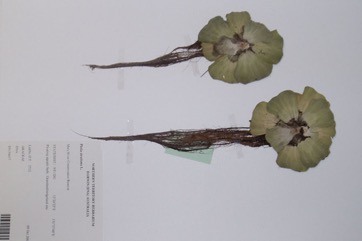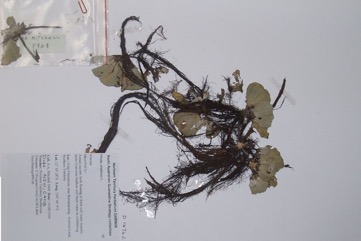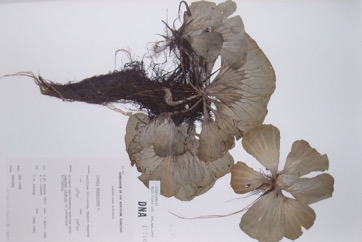Water Lettuce, Nile cabbage

A tropical plant. It is common and widely distributed in low and medium altitudes in the Philippines. It occurs on the surface of stagnant water and slow moving streams. It grows in water fields, lakes, ponds. It occurs in both the tropics and subtropics. It needs temperatures above 12°C. It grows in water rich in nutrients. It is sensitive to frost. It suits hardiness zones 9-11. In Yunnan.
Also known as:
Akasa tamarai, Alface-d'agua, Antara gange, Anthara thamara, Antharai-dhaman, Apon-apon, Apu-apu, Bahata, Borajhanji, Caa pey, Chauk, Da piao, Darahero, Golfo, Gondala, Hmaw, Jalamandvi, Jalashamkhala, Jalkhumbi, Jall khumbi, Jall shamkala, Jaru, Jauk, Kajeng apu, Kambiang, Kang-jao, Kapu-kapu, Kayu apu, Kiambang, Kiapo, Koditamarai, Kudapayal, Kumbhika, Kunhui, Lechuguilla del rio, Llanten de agua, Loloan, Mbutzemelep, Murere, Murere-page, Muttapayal, Nargis, Nirubuduki, Page, Pasta, Prasni, Quiapo, Repollito de agua, Sarebafae, Takapana, Ye-salat
Synonyms
- Pistia occidentalis Blume
- and several others
Edible Portion
- Leaves, Vegetable, Salt
Where does Water Lettuce grow?
Found in: Africa, Angola, Argentina, Asia, Australia, Benin, Bolivia, Botswana, Brazil, Burkina Faso, Cameroon, Central Africa, Chile, China, Congo, Congo R, Côte d'Ivoire, Cuba, Dominican Republic, East Africa, Gabon, Gambia, Ghana, Guam, Guatemala, Guianas, Guinea, Guinée, Guinea-Bissau, Guyana, Haiti, India, Indochina, Indonesia, Ivory Coast, Jamaica, Kenya, Laos, Liberia, Malawi, Malaysia, Maldives, Mali, Mozambique, Myanmar, Nigeria, North America, Pacific, Pakistan, Papua New Guinea, PNG, Paraguay, Philippines, Puerto Rico, SE Asia, Senegal, Sierra Leone, South America, Sri Lanka, St Helena, Sudan, Suriname, Taiwan, Tanzania, Thailand, Uganda, Uruguay, United States, Venezuela, Vietnam, West Africa, West Indies, Zambia, Zimbabwe
Notes: Plants contain stinging crystals. There is only one Pistia species. It can be invasive.
Status: It is a famine food.
Growing Water Lettuce, Nile cabbage
Cultivation: Plants are grown from pieces of the runners. They can also grow from leaves. They can be grown from seeds.
Edible Uses: The young leaves are cooked and eaten as a vegetable. They are also added to soups. CAUTION: The plant contains stinging oxalate crystals. These can be removed by boiling and changing the cooking water. The plant also accumulates heavy metals in polluted streams. Ash from the burned plants is used as a salt substitute.
Production: Leaves are available throughout the year.
Nutrition Info
per 100g edible portion| Edible Part | Energy (kcal) | Protein (g) | Iron (mg) | Vitamin A (ug) | Vitamin c (mg) | Zinc (mg) | % Water |
|---|---|---|---|---|---|---|---|
| Leaves | - | - | - | - | - | - |
Water Lettuce, Nile cabbage Photos



References
Achigan-Dako, E, et al (Eds), 2009, Catalogue of Traditional Vegetables in Benin. International Foundation for Science.
Ambasta, S.P. (Ed.), 2000, The Useful Plants of India. CSIR India. p 462
Bodkin, F., 1991, Encyclopedia Botanica. Cornstalk publishing, p 805
Bortolotto, I. M., et al, 2018, Lista preliminar das plantas alimenticias nativas de Mato Grosso do Sul, Brasil. Iheringia, Serie Botanica, Porto Alegre, 73 (supl.):101-116
Brickell, C. (Ed.), 1999, The Royal Horticultural Society A-Z Encyclopedia of Garden Plants. Convent Garden Books. p 805
Brown, W.H., 1920, Wild Food Plants of the Philippines. Bureau of Forestry Bulletin No. 21 Manila. p 32
Burkill, H. M., 1985, The useful plants of west tropical Africa, Vol. 1. Kew.
Burkill, I.H., 1966, A Dictionary of the Economic Products of the Malay Peninsula. Ministry of Agriculture and Cooperatives, Kuala Lumpur, Malaysia. Vol 2 (I-Z) p 1787
Cundall, P., (ed.), 2004, Gardening Australia: flora: the gardener's bible. ABC Books. p 1053
Dalziel, J. M., 1937, The Useful plants of west tropical Africa. Crown Agents for the Colonies London.
Facciola, S., 1998, Cornucopia 2: a Source Book of Edible Plants. Kampong Publications, p 172
Fowler, D. G., 2007, Zambian Plants: Their Vernacular Names and Uses. Kew. p 64
Gallagher, D. E., 2010, Farming beyond the escarpment: Society, Environment, and Mobility in Precolonial Southeastern Burkina Faso. PhD University of Michigan
Grubben, G. J. H. and Denton, O. A. (eds), 2004, Plant Resources of Tropical Africa 2. Vegetables. PROTA, Wageningen, Netherlands. p 564
Herb., E. A., 1981,
Heywood, V.H., Brummitt, R.K., Culham, A., and Seberg, O., 2007, Flowering Plant Families of the World. Royal Botanical Gardens, Kew. p 346
Hibbert, M., 2002, The Aussie Plant Finder 2002, Florilegium. p 235
http://www.botanic-gardens-ljubljana.com/en/plants
Hussey, B.M.J., Keighery, G.J., Cousens, R.D., Dodd, J., Lloyd, S.G., 1997, Western Weeds. A guide to the weeds of Western Australia. Plant Protection Society of Western Australia. p 20
Jardin, C., 1970, List of Foods Used In Africa, FAO Nutrition Information Document Series No 2.p 95
Jain et al, 2011, Dietary Use and Conservation Concern of Edible Wetland Plants at Indo-Burma Hotspot: A Case Study from Northeast India. Journal of Ethnobiology and Ethnomedicine 7:29 p 7
Johns, R.J. & Hay, A., 1976, Monocotyledons of Papua New Guinea. Part 1 , Forestry College Bulolo, PNG p 65
Lamp, C & Collet F., 1989, Field Guide to Weeds in Australia. Inkata Press. p 217
Lazarides, M. & Hince, B., 1993, Handbook of Economic Plants of Australia, CSIRO. p 191
Leach, G.J., & Osborne, P.L., 1985, Freshwater Plants of Papua New Guinea. UPNG Press, p 91
Llamas, K.A., 2003, Tropical Flowering Plants. Timber Press. p 85
Lugod, G.C. and de Padua L.S., 1979, Wild Food Plants in the Philippines. Vol. 1. Univ. of Philippines Los Banos. p 15
Majeed, M., et al, 2021, Gathered Wild Food Plants among Diverse Religious Groups in Jhelum District, Punjab, Pakistan. Foods 2021, 10, 594.
Malaisse, F., 1997, Se nourrir en floret claire africaine. Approche ecologique et nutritionnelle. CTA., p 91.
Malezas Comestibles del Cono Sur, INTA, 2009, Buernos Aires
Marinelli, J. (Ed), 2004, Plant. DK. p 465
Martin, F.W. & Ruberte, R.M., 1979, Edible Leaves of the Tropics. Antillian College Press, Mayaguez, Puerto Rico. p 176
McMakin, P.D., 2000, Flowering Plants of Thailand. A Field Guide. White Lotus. p 82
Mercy, N. A., et al, 2016, Survey of Wild Vegetables in the Lebialem Highlands of South Western Cameroon. Journal of Plant Sciences 4(6): 172-184
Monsalud, M.R., Tongacan, A.L., Lopez, F.R., & Lagrimas, M.Q., 1966, Edible Wild Plants in Philippine Forests. Philippine Journal of Science. p 443
Morton, J.K., 1961, West African Lilies and Orchids. Longmans. p 51
Nkeoua, G. & Boundzanga, G. C., 1999, Donnees sur les produits forestieres non ligneux en Republique du Congo. FAO. p 34
Paczkowska, G. & Chapman, A.R., 2000, The Western Australian Flora. A Descriptive Calatogue. Western Australian Herbarium. p 36
Peters, C. R., O'Brien, E. M., and Drummond, R.B., 1992, Edible Wild plants of Sub-saharan Africa. Kew. p 12
Pickering, H., & Roe, E., 2009, Wild Flowers of the Victoria Falls Area. Helen Pickering, London. p 29
Plants of Haiti Smithsonian Institute http://botany.si.edu
Polinag, M. A., 2003, Food from the Wilderness. Department of Environment and Natural Resources. Laguna.
Purseglove, J.W., 1972, Tropical Crops. Monocotyledons. Longmans p 60
Romanowski, N., 2007, Edible Water Gardens. Hyland House. p 112
Ruffo, C. K., Birnie, A. & Tengnas, B., 2002, Edible Wild Plants of Tanzania. RELMA p 528
Sainty, G.R. & Jacobs, S.W.L., 1981, Waterplants of New South Wales. Water Resources Commission. NSW p 66
Sainty, G., and Jacobs, S., 2003, Waterplants in Australia. A Field Guide. Sainty Books. p 10
Singh, H.B., Arora R.K.,1978, Wild edible Plants of India. Indian Council of Agricultural Research, New Delhi. p 39
Slocum, P.D. & Robinson, P., 1999, Water Gardening. Water Lilies and Lotuses. Timber Press. p 66
Sp. pl. 2:963. 1753
Stephens, K.M., & Dowling, R.M., 2002, Wetland Plants of Queensland. A field guide. CSIRO p 8
Staples, G.W. and Herbst, D.R., 2005, A tropical Garden Flora. Bishop Museum Press, Honolulu, Hawaii. p 610 (Drawing)
Sujanapal, P., & Sankaran, K. V., 2016, Common Plants of Maldives. FAO & Kerala FRI, p 210
Sukarya, D. G., (Ed.) 2013, 3,500 Plant Species of the Botanic Gardens of Indonesia. LIPI p 1153
Swapna, M. M. et al, 2011, A review on the medicinal and edible aspects of aquatic and wetland plants of India. J. Med. Plants Res. 5 (33) pp. 7163-7176
WATT,
Williamson, J., 2005, Useful Plants of Malawi. 3rd. Edition. Mdadzi Book Trust. p 201
World Checklist of Useful Plant Species 2020. Royal Botanic Gardens, Kew